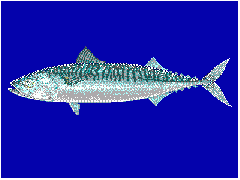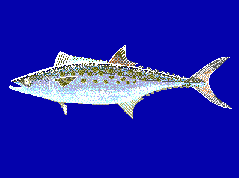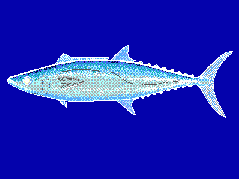Mackerel
Mackerel is a common name for various swift-moving, marine fish of the Scrombidae family of the Perciformes order, with the exception of the similar, but deeper-bodied tunas (tribe Thunnini) and the bonitos (tribe Sardini) that are also part of the same family. Mackerels, and all of the members of the Scrombidae family, are characterized by a long, slender, streamlined body; deeply forked tails; a very narrow portion of body right before the tail; and finlets behind the second dorsal and the anal fins. The term mackerel is also applied to all members of the Scrombidae family, which is sometimes known as the mackerel family. Furthermore, the term also is used as a common name for various other fish in other families, such as the jack mackerels in the Carangidae family in the same Perciformes order.
Mackerel provide important commercial, nutritional, recreational, and ecological values. They are prized as a food fish and for recreational sports fishing, are the basis of an important commercial fishery, and are key to many marine food chains.
Overview
Mackerels are part of the Scrombridae family of the Suborder Scrombroidei. The family includes mackerels, tunas, and bonitos. The suborder includes also barracudas, snake mackerels (family Gempylidae), and cutlassfishes (Nelson 1994).
Members of the Scombridae family have two dorsal fins with five to 12 finlets behind the second dorsal and the anal fins (Nelson 1994). The first dorsal fin has nine to 27 rays, the pelvic fins have six rays and are placed behind the pectoral fins, which are high on the body (Nelson 1994). Mackerels, like tunas, have a deeply forked or crescent-shaped tail, and the body is very narrow right before the tail.
Within the family, Nelson (1994) recognizes two subfamilies: Gasterochismatinae, with just one species (Gasterochisma melampus, the bigscale mackerel or butterfly mackerel) and Scombrinae (with 14 genera of mackerels, tunas, and bonitas). The tunas are placed in the Thunnini tribe and bonitos in the Sardinia tribe.
The "true mackerels" comprise the tribe Scombrini, with two genera, Scomber and Rastrelliger and six species (Nelson 1994). The tribe Grammatorcynini has one genus, Grammatorcynus, with two species of "double-lined mackerels." The tribe Scomberomorini has two genera, Acanthocybium and Scomberomorus with 19 species that comprise the "Spanish mackerels."
Description
Mackerels can be found in all tropical and temperate seas. Most live offshore in the oceanic environment, but a few, like the Spanish mackerel (Scomberomorus maculatus), enter bays and can be caught near bridges and piers.
Common features of mackerels are a slim, cylindrical shape (as opposed to the tunas, which are deeper bodied) and numerous finlets on the dorsal and ventral sides behind the dorsal and anal fins. The scales are extremely small, if present. They are fast swimming. A female mackerel may lay 500,000 eggs at one time.
Among well-known species of mackerel are the king mackerel, Atlantic mackerel, and the blue mackerel.
The king mackerel, Scomberomorus cavalla, is the largest species called mackerel. It can grow to 66 inches (1.68 meters). It is a migratory species that lives its entire life in the open waters of the western Atlantic Ocean and Gulf of Mexico. It is an important species to both the commercial and recreational fishing industries. King mackerel commonly occur in depths of 40 to 150 feet (12‚Äď45¬†m), where the principal fisheries occur. Larger kings (heavier than 20 lb or nine kg) often occur inshore, in the mouths of inlets and harbors, and occasionally even at the 600 foot (180¬†m) depths at the edge of the Gulf Stream.
The Atlantic mackerel, Scomber scombrus, is a pelagic schooling species of mackerel found on both sides of the North Atlantic Ocean. The species is also called Boston mackerel or just mackerel. It is an important food fish. Although Atlantic mackerel have been somewhat depleted in the waters around Europe, the Atlantic mackerel population apparently persists at abundant levels in U.S. waters despite being overfished in the 1970s.
The blue mackerel, Japanese mackerel, or Pacific mackerel, Scomber australasicus, is found in tropical and subtropical waters of the Pacific ocean, the Red Sea, and the Gulf of Oman and the Gulf of Aden, in surface waters down to 650 feet (200 meters). It is one of the smallest members of the mackerel family, attaining a length of 12 to 20 inches (20 to 55 cm) and a weight of about 2.2 pounds (one kilogram). The first dorsal fin is triangular, the second much lower followed by serrated finlets to the deeply forked tail. The body is fully scaled. There is a single row of sharp teeth in each jaw, the ones in the lower being larger. There is a swim bladder present.
Importance
Mackerel are prized as a food fish and for recreational sports fishing. They are the base of an important commercial fishery.
As a food fish, the meat of mackerels tends to be oily. It is rich in protein and vitamins D, B2, B6, and B12, as well as niacin, copper, iodine, and selenium (Bender and Bender 2005). It also are a source of iron and vitamin B1. Atlantic mackerel is extremely high in vitamin B12, and is also very high in omega 3, containing nearly twice as much per unit weight as does salmon. Unlike King mackerel and Spanish mackerel, Northern Atlantic mackerel are very low in mercury, and can be eaten at least twice a week according to United States Environmental Protection Agency (EPA) guidelines.
The king mackerel has a high-fat flesh with a pleasant savory flavor, making it quite popular (Herbst 2001). As of 2005, king mackerel are primarily marketed fresh. They may be sold as fillets, steaks, or in the round (whole). Their raw flesh is grayish, due to its high fat content, They are generally prepared by broiling, frying, baking, or, especially for a large "smoker" king, by smoking. However, according to the EPA, king mackerel is one of the four fish that children and women of child-bearing age should avoid due to high levels of methylmercury found in these fish.
Atlantic mackerel are sought after for food either cooked or as sashimi.
Mackerel can spoil quickly, especially in the tropics, causing scombroid food poisoning; it should be eaten on the day of capture, unless cured. For this reason, mackerel is the only fish traditionally sold on a Sunday in London, and is the only common salt-cured sushi. Mainly in Scandinavia, canned mackerel in tomato sauce is commonly used as sandwich filling.
Mackerel, like the tunas, are important in food chains, consuming fish, plankton, and mollusks, and being consumed by sharks, rays, billfishes, larger tunas, and toothed whales. The blue mackerel feeds upon copepods and other crustaceans, squid, and small fish.
Species whose common name includes "mackerel"
Family Scombridae
Scombridae is the "mackerel family," placed within the Scombroidei subfamily of the Perciformes order.
- Atlantic mackerel, Scomber scombrus
- Atlantic Spanish mackerel, Scomberomorus maculatus
- Blue mackerel, Scomber australasicus
- Broadbarred king mackerel, Scomberomorus semifasciatus
- Chub mackerel, Scomber japonicus
- Australian spotted mackerel, Scomberomorus munroi
- Double-lined mackerel, Grammatorcynus bilineatus
- Happened mackerel, Happundreus maculatus
- Indian mackerel, Rastrelliger kanagurta
- Indo-Pacific king mackerel, Scomberomorus guttatus
- Island mackerel, Rastrelliger faughni
- Japanese Spanish mackerel, Scomberomorus niphonius
- King mackerel, Scomberomorus cavalla
- Spanish mackerel, Scomberomorus macula
- Streaked Spanish mackerel, Scomberomorus lineolatus
- Spotted Spanish mackerel, Scomberomorus guttus
Family Gempylidae
Gempylidae, the snake mackerels, is a family of oblong or elongate and compressed marine fish also within the Scombroidei subfamily (Nelson 1994). They are often found in very deep water.
- Black snake mackerel, Nealotus tripes
- Blacksail snake mackerel, Thyrsitoides marleyi
- Snake mackerel, Gempylus serpens
- Violet snake mackerel, Nesiarchus nasutus
- White snake mackerel, Thyrsitops lepidopoides
Family Carangidae
Carangidae is a family of fish that is part of the order Perciformes, but not the suborder Scombroidei. It includes the jacks, pompanos, jack mackerels, and scads. Jack mackerels are marine fishes in the Trachurus genus of the Carangidae family. The genus contains many important commercial and game fish, such as the Pacific jack mackerel, Trachurus symmetricus.
- Atlantic horse mackerel, Trachurus trachurus
- Blue jack mackerel, Trachurus picturatus
- Cape horse mackerel, Trachurus capensis
- Cunene horse mackerel, Trachurus trecae
- Greenback horse mackerel, Trachurus declivis
- Japanese horse mackerel, Trachurus japonicus
- Mediterranean horse mackerel, Trachurus mediterraneus
- Jack mackerel, Trachurus symmetricus
Family Hexagrammidae
Hexagrammidae are part of the Scorpaeniformes order.
- Okhostk Atka mackerel, Pleurogrammus azonus
- Atka mackerel, Pleurogrammus monopterygius
Use as an adjective
"Mackerel" is also used as an adjective in the vernacular names of other animals or breeds thereof, often used to indicate types with a mackerel-like pattern of vertical stripes:
- Mackerel icefish - Champsocephalus gunnari
- Mackerel pike - Cololabis saira
- Mackerel scad - Decapterus macarellus
- Mackerel shark - several species
- Sharp-nose mackerel shark - Isurus oxyrinchus
- Mackerel trevalla - Seriolella punctata
- Mackerel tuna - Euthynnus affinis
- Mackerel tabby cat - Felis silvestris catus
- Mackerel Tail Goldfish - Carassius auratus
ReferencesISBN links support NWE through referral fees
- Bender, D. A., and A. E. Bender. 2005. A Dictionary of Food and Nutrition. New York: Oxford University Press. ISBN 0198609612.
- Herbst, S. T. 2001. The New Food Lover's Companion: Comprehensive Definitions of Nearly 6,000 Food, Drink, and Culinary Terms (Barron's Cooking Guide). Hauppauge, NY: Barron's Educational Series. ISBN 0764112589.
- Nelson, J. S. 1994. Fishes of the World, 3rd ed. New York: John Wiley & Sons. ISBN 0471547131.
Credits
New World Encyclopedia writers and editors rewrote and completed the Wikipedia article in accordance with New World Encyclopedia standards. This article abides by terms of the Creative Commons CC-by-sa 3.0 License (CC-by-sa), which may be used and disseminated with proper attribution. Credit is due under the terms of this license that can reference both the New World Encyclopedia contributors and the selfless volunteer contributors of the Wikimedia Foundation. To cite this article click here for a list of acceptable citing formats.The history of earlier contributions by wikipedians is accessible to researchers here:
- Mackerel  history
- Atlantic_mackerel  history
- Blue_mackerel  history
- King_mackerel  history
- Trachurus  history
The history of this article since it was imported to New World Encyclopedia:
Note: Some restrictions may apply to use of individual images which are separately licensed.



